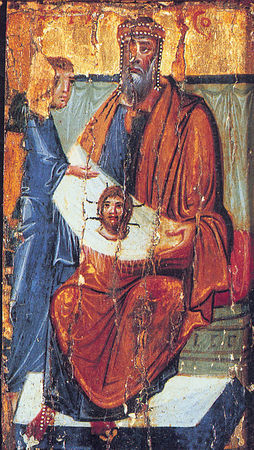 |
| The earliest image of Jesus Christ "Not Made by Hands" from all extant images, XIIth century |
 The Transfer from
The Transfer from
Ananias arrived in Jerusalem and saw the Lord surrounded by people. He was not able to get close to Him because of the large throng of people listening to the preaching of the Savior. Then he stood on a high rock and attempted to paint the portrait of the Lord Jesus Christ from afar, but this effort was not successful. The Savior saw him, called to him by name and gave him a short letter for Abgar in which He praised the faith of this ruler. He also promised to send His disciple to heal him of his leprosy and guide him to salvation.
Then the Lord asked that water and a cloth be brought to Him. He washed His Face, drying it with the cloth, and His Divine Countenance was imprinted upon it. Ananias took the cloth and the letter of the Savior to Edessa . Reverently, Abgar pressed the holy object to his face and he received partial healing. Only a small trace of the terrible affliction remained until the arrival of the disciple promised by the Lord. He was St Thaddeus, Apostle of the Seventy (August 21), who preached the Gospel and baptized Abgar and all the people of Edessa . Abgar put the Holy Napkin in a gold frame adorned with pearls, and placed it in a niche over the city gates. On the gateway above the icon he inscribed the words, "O Christ God, let no one who hopes on Thee be put to shame."
For many years the inhabitants kept a pious custom to bow down before the Icon Not-Made-by-Hands, when they went forth from the gates. But one of the great-grandsons of Abgar, who later ruled Edessa , fell into idolatry. He decided to take down the icon from the city wall. In a vision the Lord ordered the Bishop of Edessa to hide His icon. The bishop, coming by night with his clergy, lit a lampada before it and walled it up with a board and with bricks.
Many years passed, and the people forgot about it. But in the year 545, when the Persian emperor Chozroes I besieged Edessa and the position of the city seemed hopeless, the Most Holy Theotokos appeared to Bishop Eulabius and ordered him to remove the icon from the sealed niche, and it would save the city from the enemy. Having opened the niche, the bishop found the Icon Not-Made-by-Hands: in front of it was burning the lampada, and upon the board closing in the niche, a copy of the icon was reproduced. After a church procession with the Icon Not-Made-by-Hands had made the circuit of the city walls, the Persian army withdrew.
In the year 630 Arabs seized Edessa , but they did not hinder the veneration of the Holy Napkin, the fame of which had spread throughout all the East. In the year 944, the emperor Constantine Porphyrogenitos (912-959) wanted to transfer the icon to the Constantinople , and he paid a ransom for it to the emir of the city. With great reverence the Icon of the Savior Not-Made-by-Hands and the letter which He had written to Abgar, were brought toConstantinople by clergy.
On August 16, the icon of the Savior was placed in the Tharossa church of the Most Holy Theotokos. There are several traditions concerning what happened later to the Icon Not-Made-by-Hands. According to one, crusaders ran off with it duringtheir rule at Constantinople (1204-1261), but the ship on which the sacred object was taken, perished in the waters of the Sea of Marmora
According to another tradition, the Icon Not-Made-by-Hands was transported around 1362 to Genoa , where it is preserved in a monastery in honor of the Apostle Bartholomew. It is known that the Icon Not-Made-by-Hands repeatedly gave from itself exact imprints. One of these, named "On Ceramic," was imprinted when Ananias hid the icon in a wall on his way to Edessa ; another, imprinted on a cloak, wound up in Georgia . Possibly, the variance of traditions about the original Icon Not-Made-by-Hands derives from the existence of several exact imprints.
During the time of the Iconoclast heresy, those who defended the veneration of icons, having their blood spilt for holy icons, sang the Troparion to the Icon Not-Made-by-Hands. In proof of the validity of Icon-Veneration, Pope Gregory II (715-731) sent a letter to the Byzantine emperor, in which he pointed out the healing of King Abgar and the sojourn of the Icon Not-Made-by-Hands at Edessa as a commonly known fact. The Icon Not-Made-by-Hands was put on the standards of the Russian army, defending them from the enemy. In the Russian Orthodox Church it is a pious custom for a believer, before entering the temple, to read the Troparion of the Not-Made-by-Hand icon of the Savior, together with other prayers.
Source
Комментариев нет:
Отправить комментарий